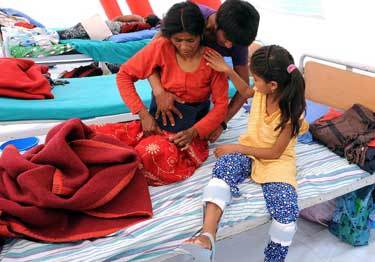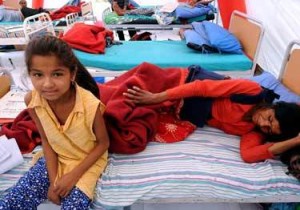尼泊爾少女Ramita重展笑臉
2015-06-01
By Avinashi Paudel
KATHMANDU/ HONG KONG, Nepal, 1 June 2015 – Ramita Giri, 11, was eating her lunch on the porch of her house in Jyamire, Sindhupalchowk, when the earthquake struck Nepal on 25 April. Confused, she rushed inside in search of her mother.
| “I was calling ‘Mommy! Mommy!’ at the top of my voice,” Ramita recalls. “Then suddenly the house fell upon us. It was after four hours that my other pulled me out of the rubble.” Ramita was unconscious for most of the time she lay in the ruins. She has vague memories of people struggling to remove her from under a wooden beam. Ramita was not the only one in her house who was hurt in the quake, which has taken more than 8,000 lives and injured almost tripled that number. Five other members of her family were trapped under the house and injured, some critically. Her mother, Sita, suffered spinal injury, and Ramita herself was uised and wounded. Increasing patients |
 © UNICEF/PFPG2015-3075/Karki
Ramita Giri, 11, watches carefully as her other Ram fastens their mother's back ace at the Spinal Injury Rehabilitation Center in Nepal's Kavrepalanchowk district. |
“Before the earthquake, we used to have an average of 40 patients in our 52-bed capacity centre,” says Esha Thapa Dhungana, Executive Director of the centre. “But right after the earthquake, the number doubled and currently has almost tripled.”Health workers at the Spinal Injury Rehabilitation Centre who have been deployed to different hospitals of Kathmandu have reported that many patients are likely to be referred to the centre from those hospitals. UNICEF has delivered medical tents and blankets in order to support the centre in accommodating the increasing number of patients.
“These tents from UNICEF will be used for D-Zone patients, or those patients who have completed rehab and have gained some mobility and independence” explains Ms. Dhungana.
 © UNICEF/PFPG2015-3079/Karki
Ramita sits at the foot of the bed where her mother rests in the Spinal Injury Rehabilitation Centre. |
Patients with spinal injury need loger-term care and must undergo a series of therapies before being released. “These tents will definitely help our staff to manage the space, as well as the limited resources we have efficiently and provide the best possible rehabilitation service to our patients,” Ms. Dhungana adds. Hopes for the future More than 400 health facilities were destroyed and nearly 700 were damaged by the earthquake. Tents like those at the Spinal Injury Rehabilitation Centre have been a boon for hospitals, health posts, birthing centres and shelter homes for pregnant and new mothers. |
| Donate NOW to support Nepal Earthquake response |









